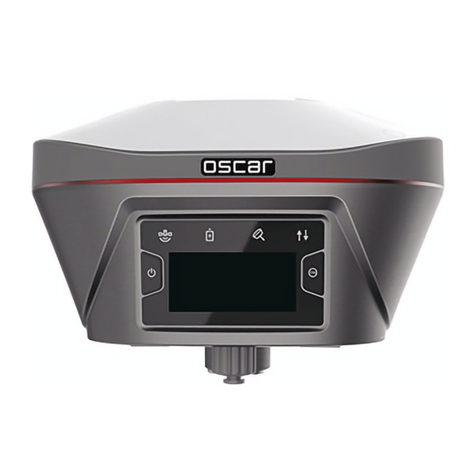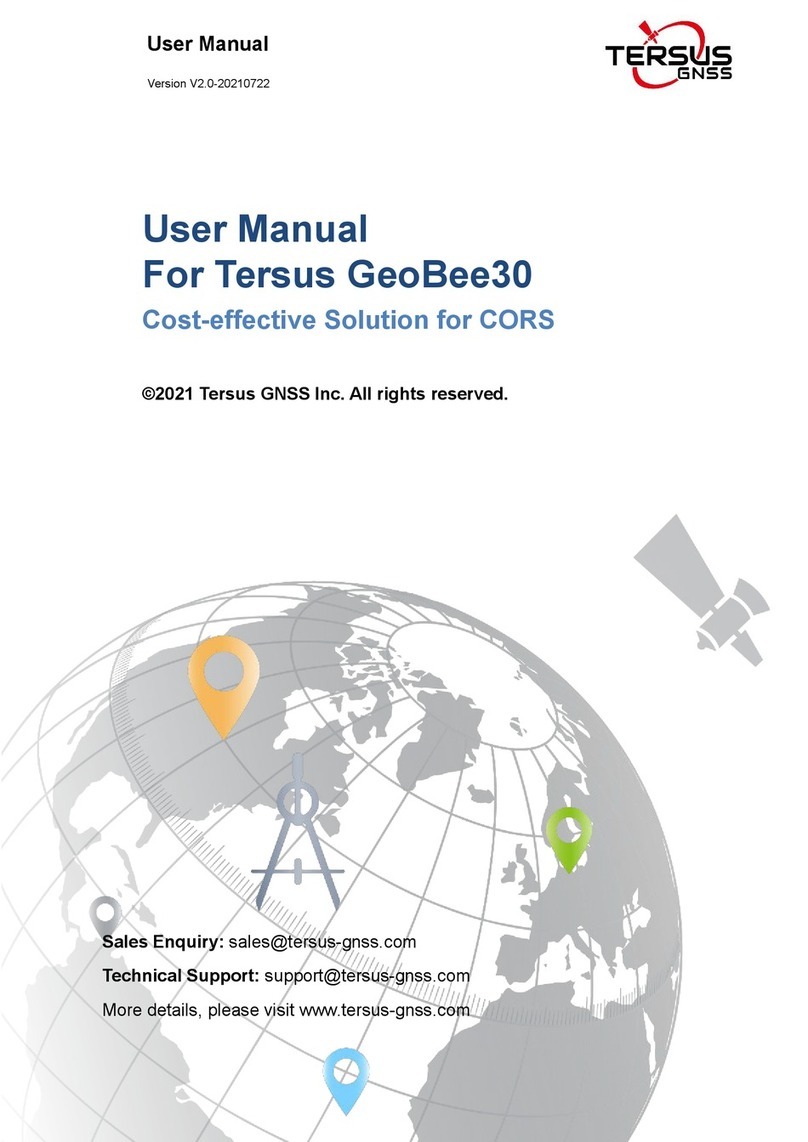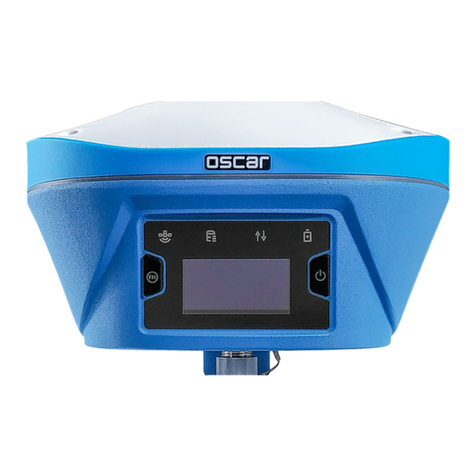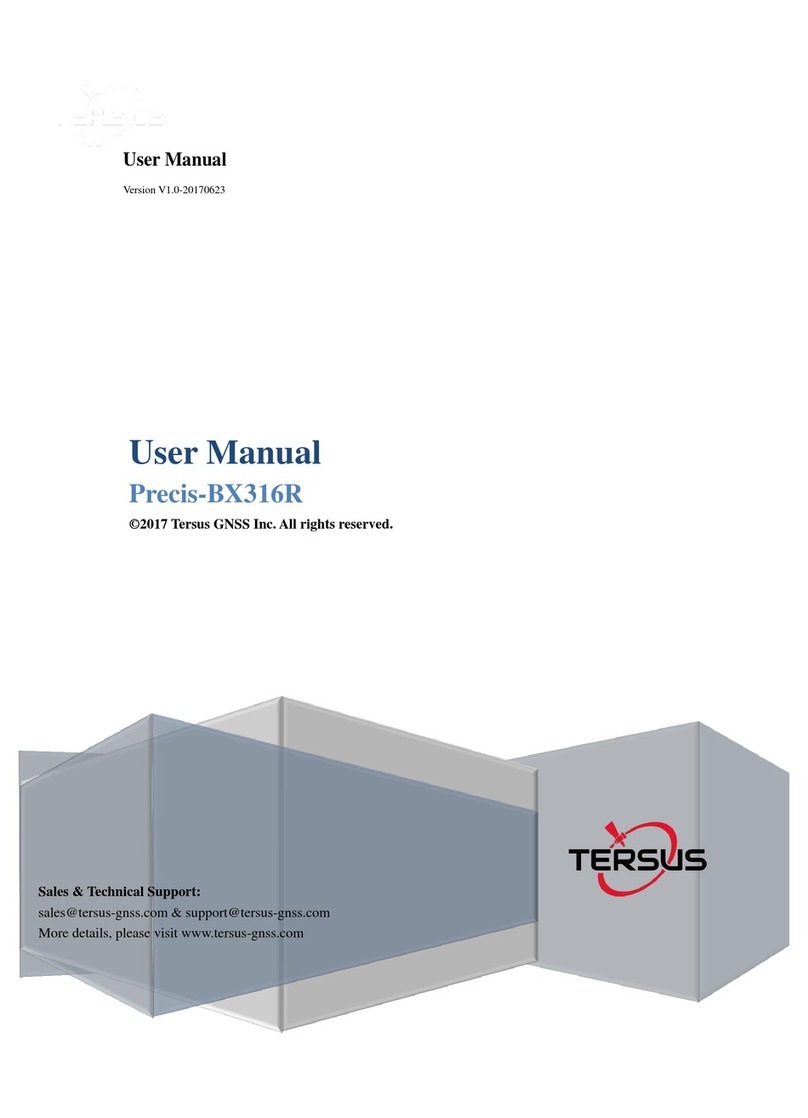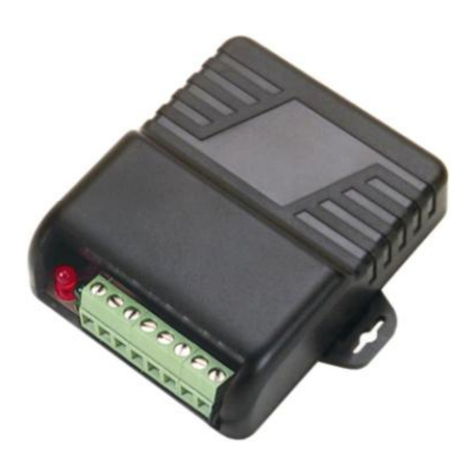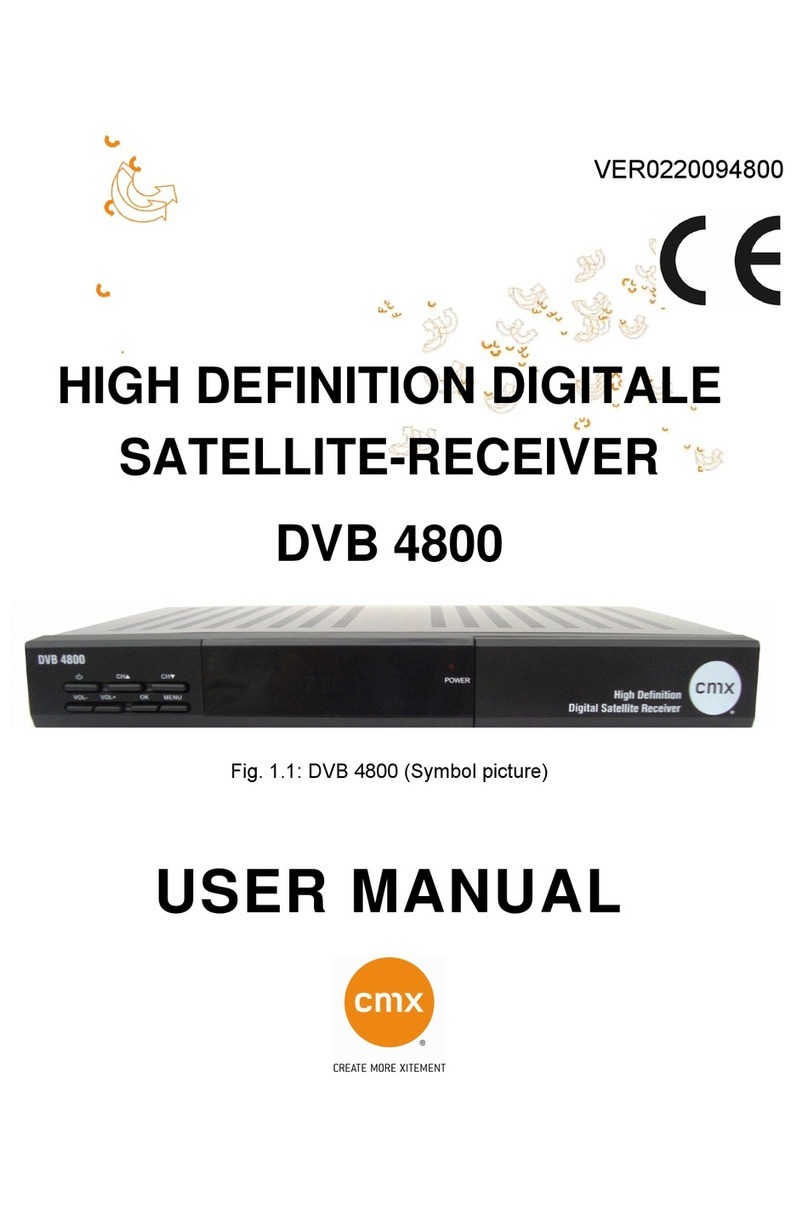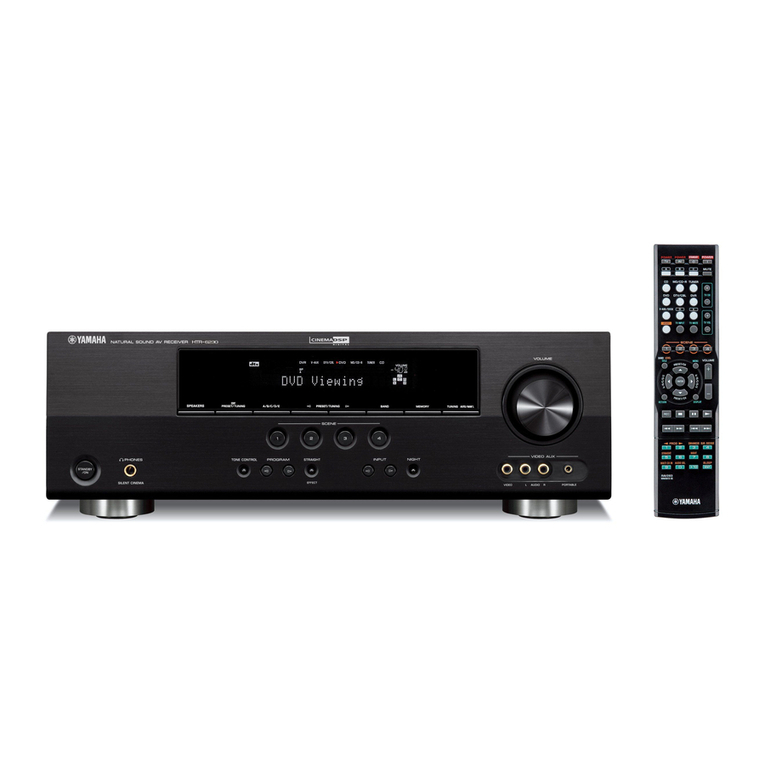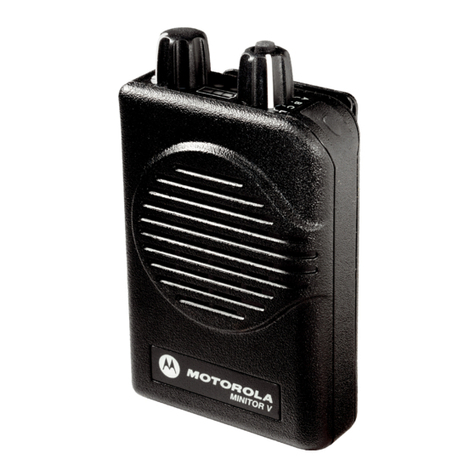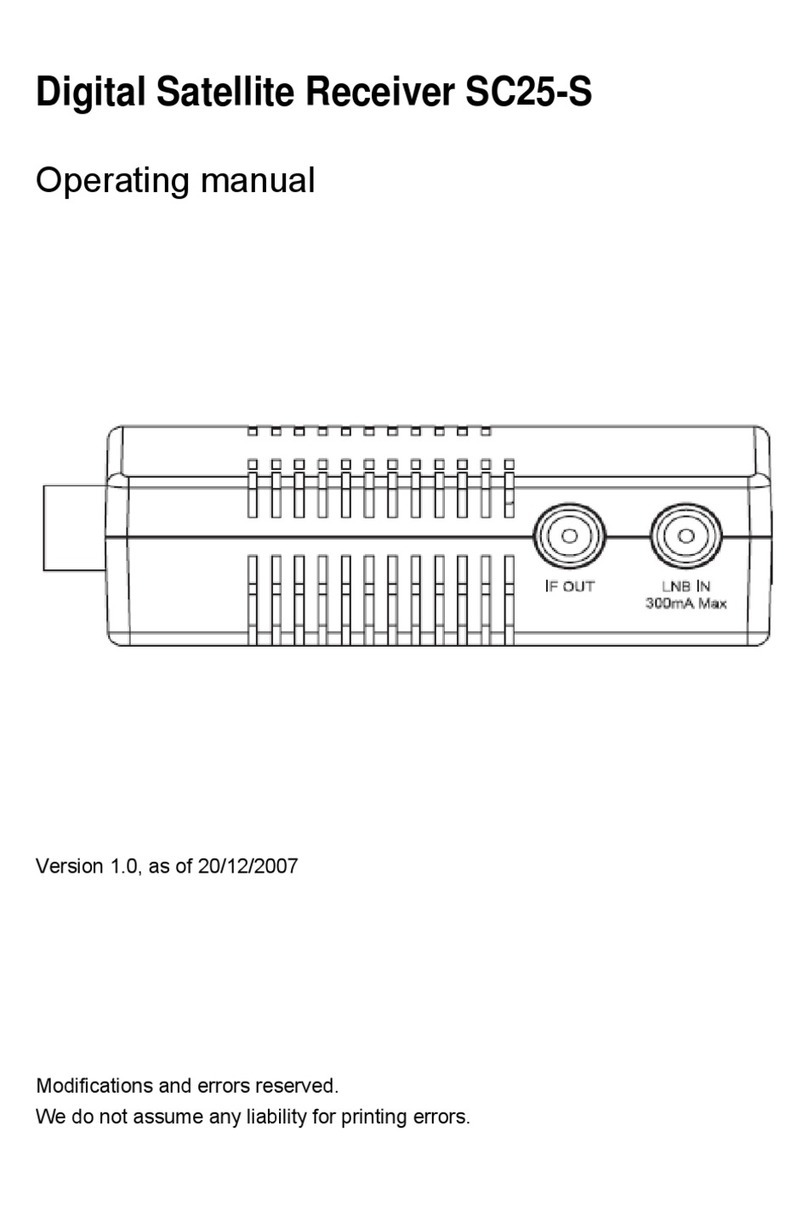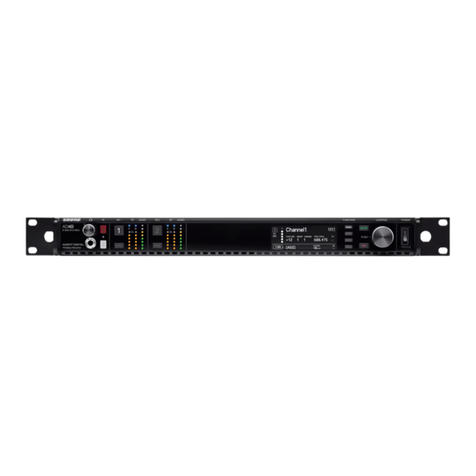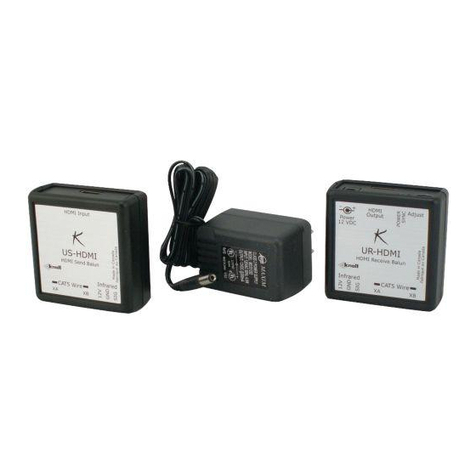TERSUS Oscar User manual

User Manual
Version V2.4-20220419
Oscar GNSS Receiver
User Manual
©2022 Tersus GNSS Inc. All rights reserved.
More details, please visit: www.tersus-gnss.com

User Manual Version 2.4 – 20220419
1
Revision History
Version
Revision Date
Change Summary
1.0
20190731
Initial Release
1.1
20191122
Change Yellow&Blue LED to Green LED for Oscar Basic;
Add eBubble in section 2.2.2; Update section 1.3.3;
Update section 2.4.1; Update section 4.4.
1.2
20200410
Update section 2.4.1, add section 4.4 for tilt function, add
table 3.4 for internal radio.
1.3
20200604
Add notice of WEEE; Add view description for LEMO
connectors; Add registration steps in section 2.2.2;
Update logo picture.
1.4
20200623
Add section 2.5 for web UI.
1.5
20201201
Update section 2.4.1 for firmware upgrade; Update table
3.4 for configuration of internal radio; Update section 4.4
for the LED status of tilt measurement; Update section 4.5
issues and solutions.
1.6
20210324
Update website links in table 0.1 and section 2.4.1; Add a
note for firmware upgrade; Add pin definition of TNC
connector and battery contacts; Update section 2.3 Data
download; Update table 3.1.
1.7
20210610
Update section 2.4.1 for firmware upgrade,add 2.5 Web
UI(User Interface);Add Table3.8 Transmitter distance
(Typical);Add Vibration:MIL-STD-810G,FIG.514.6C-1.
1.8
20210727
Add section2.2.1.1 panel options and operation
introduction; upgrade section 2.2.2.3 scan code & 3.1
Technical specifications
1.9
20210809
Add section 2.6 battery change mode; upgrade section2.5
Web UI
2.0
20210913
Update section2.3.3
2.1
20211108
Update section2.4
2.2
20211124
Upgrade section3.4 & 1.3.4 & 3.1 & 2.4.2
2.3
20220309
Add section 2.1.4 Oscar external power supply; add
section 2.2.2.5 configure NMEA via serial port
2.4
20220419
Add TC50

User Manual for Oscar GNSS Receiver v2.4
2
Notices
CE Marking
Tersus GNSS Inc. declares that Oscar GNSS receiver is in compliance with
the essential requirements (radio performance, electromagnetic compatibility
and electrical safety) and other relevant provisions of Radio Equipment
Directive 2014/53/EU, Electromagnetic Compatibility (EMC) Directive
2014/30/EU, and Low voltage (LVD) Directive 2014/35/EU. Therefore the
equipment is labeled with the following CE-marking.
The Declaration of Conformity may be obtained from Tersus GNSS Inc.
RCM Marking
Tersus GNSS Inc. declares that Oscar GNSS receiver is in compliance with
the essential requirements (electrical safety, EMC, & telecommunications)
from Australian & New Zealand RCM compliance requirements. Therefore the
equipment is labeled with the following RCM-marking.
The Declaration of Conformity may be obtained from Tersus GNSS Inc.

User Manual for Oscar GNSS Receiver v2.4
3
KC Marking
Tersus GNSS Inc. declares that Oscar GNSS receiver is in compliance with
the essential requirements for safety certification of electrical products from
Korea Agency for Technology and Standards (KATS). Therefore the equipment
is labeled with the following KC-marking.
Restriction of User of Certain Hazardous Substances (RoHS)
Tersus GNSS Inc. declares that Oscar GNSS receiver is in compliance with
the restriction of the use of certain hazardous substances in electrical and
electronic equipment (RoHS) RoHS Directive 2011/65/EU and its Amendment
Directives (EU) 2015/863.
Waste Electrical and Electronic Equipment (WEEE)
This product must not be disposed with household
waste.
Dispose of the product appropriately in accordance
with the national regulations in force in your country.
Always prevent access to the product by unauthorised
personnel.
Product-specific treatment and waste management information can be
received from your local Tersus distributor.

User Manual for Oscar GNSS Receiver v2.4
4
Safety Information
Make sure that you have read and understood all safety requirements before
you start using Tersus product.
Conventions
The following conventions are used in this manual:
!
Information that supplements or clarifies text.
A caution that actions, operation or configuration may lead to incorrect
or improper use of the hardware.
The following notices apply to all three versions of Oscar GNSS receivers.
Operating or storing the receiver outside the specified temperature
range can damage it.
Changes or modifications to this equipment not expressly approved by
Tersus could void the user’s authority to operate this equipment or
even has risk to damage the receivers.
Install the radio antenna before switching the radio transceiver to
A warning that actions, operation or configuration may result in
regulatory noncompliance, safety issues or equipment damage.
DO NOT use the receiver in a thunderstorm as there is increasing risk
of being stuck by lightning.

User Manual for Oscar GNSS Receiver v2.4
5
transmit mode, or the radio transceiver may be damaged due to
overheating. The energy to be transmitted cannot be emitted out
without the antenna, which may cause the temperature rise and
overheat of the radio module.
Safety: exposure to radio frequency (RF)
Exposure to RF energy is an important safety consideration. Although
our product is compliance with the safety standard released by various
standard organizations, the following precautions are recommended to
ensure low exposure to radio frequency radiation.
DO NOT operate the transmitter when someone is within the
following distances of the antenna:
Bluetooth, Wi-Fi, GSM/UTMS – less than 20cm
410-470MHz UHF radio – less than 47cm
DO NOT operate the transmitter unless all RF connectors are
secured and any open connectors are properly terminated.
DO NOT operate the equipment near electrical blasting caps or in
an explosive atmosphere.
All equipment must be properly grounded.
All equipment should be serviced only by a qualified technician.

User Manual for Oscar GNSS Receiver v2.4
6
Related Documentation
Table 0.1 Document and software used in this user manual
Name
Description
Link
Log & Command
document
Document providing all the loggings
output from BX series receivers and
all the commands to the receivers.
https://www.tersus-gnss.com/document
under GNSS OEM Board / User Manual
Tersus Tool Suite
Tersus Tools including
TersusDownload, TersusGeoPix,
TersusGNSSCenter, TersusUpdate,
TersusRinexConverter
https://www.tersus-gnss.com/software
Nuwa
Survey application running in the
Android platform, David, Oscar and
other NMEA devices can be
configured with Nuwa.
https://www.tersus-gnss.com/software/osc
ar-gnss-receiver
Tersus
Geomatics Office
Post processing tool for static data.
https://www.tersus-gnss.com/software/davi
d-receiver
Support
If there is any problem and the information needed cannot be found in the
product documentation, log a technical support ticket in our tracking system
https://tersus.supportsystem.com/ , or mail to support@tersus-gnss.com.

User Manual for Oscar GNSS Receiver v2.4
7
Table of Content
Revision History .............................................................................................................1
Notices ........................................................................................................................... 2
Safety Information ..........................................................................................................4
Table of Content ............................................................................................................ 7
List of Figures .............................................................................................................. 10
List of Tables ................................................................................................................13
1. Introduction .............................................................................................................. 14
1.1 Overview ............................................................................................................ 14
1.2 Receiver features ...............................................................................................15
1.3 Devices in the package ......................................................................................16
1.3.1 Oscar GNSS receiver ..................................................................................16
1.3.2 Battery and charger .....................................................................................23
1.3.3 TC20 controller ............................................................................................26
1.3.4 TC50 controller ............................................................................................29
1.3.5 External radio for Oscar .............................................................................. 32
1.3.6 Other accessories ....................................................................................... 34
2.General Operations .................................................................................................. 40
2.1Setting up Oscar ................................................................................................. 40
2.1.1 Insert the battery ......................................................................................... 40
2.1.2 Insert the SIM card ......................................................................................42
2.1.3 Fix Oscar on a tripod or ranging pole ......................................................... 43
2.1.4 Oscar external power supply ...................................................................... 45
2.2Oscar configuration .............................................................................................46
2.2.1Configure via buttons ................................................................................... 46
2.2.2Configure via TC20/TC50 controller ............................................................ 52

User Manual for Oscar GNSS Receiver v2.4
8
2.3Data download .................................................................................................... 61
2.3.1Connection ................................................................................................... 61
2.3.2Download static data....................................................................................61
2.3.3Download debug data .................................................................................. 62
2.4Firmware upgrade ...............................................................................................64
2.4.1Wired upgrade ..............................................................................................64
2.4.2Wireless upgrade ......................................................................................... 70
2.5Web UI ................................................................................................................ 77
2.6Battery change mode ..........................................................................................81
2.7Operations of TC20 controller .............................................................................82
2.7.1Insert SIM card and Micro SD card ..............................................................82
2.7.2Micro SD Card ..............................................................................................84
2.7.3Using of touch screen .................................................................................. 85
2.8Operations of TC50 controller .............................................................................86
2.8.1Insert SIM card and SD card ........................................................................86
2.8.2Using of touch screen .................................................................................. 87
3.Technical Specifications ........................................................................................... 88
3.1Oscar GNSS receiver ......................................................................................... 88
3.2TC20 controller ....................................................................................................91
3.3TC50 controller ....................................................................................................93
3.4External radio for Oscar ......................................................................................94
3.5Radio whip antenna ............................................................................................ 96
4.Typical Applications ..................................................................................................97
4.1Base station operation ........................................................................................ 98
4.2Rover operation ................................................................................................ 104
4.3Static survey ......................................................................................................109
4.4Tilt survey and stakeout ....................................................................................111
4.4.1 Tilt initialization ..........................................................................................111
4.4.2 Tilt survey .................................................................................................. 112

User Manual for Oscar GNSS Receiver v2.4
9
4.4.3 Tilt stakeout ............................................................................................... 114
4.5Issues and solutions ......................................................................................... 115
5.Terminology ............................................................................................................ 119

User Manual for Oscar GNSS Receiver v2.4
10
List of Figures
Figure 1.1 Oscar GNSS receiver - Ultimate ......................................... 16
Figure 1.2 Oscar GNSS receiver - Advanced ..................................... 16
Figure 1.3 Oscar GNSS receiver - Basic ............................................ 16
Figure 1.4 Buttons and display on Oscar Ultimate ............................... 18
Figure 1.5 Buttons and display on Oscar Advanced .............................19
Figure 1.6 Buttons and LEDs on Oscar Basic ...................................... 20
Figure 1.7 Bottom of Oscar GNSS receiver ......................................... 22
Figure 1.8 BN20 Battery .......................................................................23
Figure 1.9 CN20 Charger ..................................................................... 23
Figure 1.10 CN20 Charger with two BN20 batteries ............................ 24
Figure 1.11 CN20 Charger Adapter ...................................................... 24
Figure 1.12 CN20 Charger Adapter Cable (A/B/C/E/N) ........................25
Figure 1.14 TC20 lithium battery .......................................................... 28
Figure 1.15 TC20 charger adapter ....................................................... 28
Figure 1.16 TC20 charger adapter plugs ..............................................28
Figure 1.17 TC20 controller hand strap ................................................29
Figure 1.18 Stylus pen for TC20 ...........................................................29
Figure 1.19 External radio for Oscar .................................................... 32
Figure 1.20 High gain radio antenna .................................................. 33
Figure 1.21 Telescopic pole for radio antenna ....................................33
Figure 1.22 Serial-5pin to External-Radio-DC-5pin & Bullet-DC Cable 33
Figure 1.23 Bullet-DC to Alligator Clips ................................................ 34
Figure 1.24 GNSS antenna connector ................................................. 34
Figure 1.25 Height measure accessory ................................................34
Figure 1.26 Tape measure ....................................................................35
Figure 1.27 410-470MHz radio whip antenna .....................................35

User Manual for Oscar GNSS Receiver v2.4
11
Figure 1.28 Mini USB cable ..................................................................35
Figure 1.29 Mini-USB OTG cable .........................................................36
Figure 1.30 Extension pole 30cm .........................................................36
Figure 1.31 Metal fixing plate ............................................................... 36
Figure 1.32 Ranging Pole .....................................................................37
Figure 1.33 Bracket for TC20 ............................................................... 37
Figure 1.34 Carrying Case ................................................................37
Figure 1.35 Tool bag .............................................................................38
Figure 1.36 Serial-5pin to DC JACK & DB9 male cable ....................... 38
Figure 1.37 DC JACK male with two wires ...........................................38
Figure 1.38 DB9 Female to USB Type A Male converter cable ............ 39
Figure 1.39 Configuration cable for 25W radio .....................................39
Figure 2.1 Open the battery cover ...................................................... 40
Figure 2.2 Put one battery in Oscar ......................................................40
Figure 2.3 Insert the SIM card ..............................................................42
Figure 2.4 Oscar as a base without radio antenna ...............................43
Figure 2.5 Oscar as a rover without radio antenna .............................. 44
Figure 2.6 Device functional group .......................................................52
Figure 2.7 Connect Oscar via Bluetooth .............................................53
Figure 2.8 Device info of Oscar ............................................................ 53
Figure 2.9 eBubble before adjusting .....................................................54
Figure 2.10 eBubble after adjusting ..................................................... 54
Figure 2.11 Example of Oscar’s registration file ................................... 55
Figure 2.12 Base configuration ............................................................ 56
Figure 2.13 Rover configuration ........................................................... 56
Figure 2.14 Link status of Base ............................................................ 57
Figure 2.15 Link status of Rover .......................................................... 57
Figure 2.16 Connect Oscar to a computer ........................................... 61

User Manual for Oscar GNSS Receiver v2.4
12
Figure 2.17 Static record folder ............................................................ 62
Figure 2.18 Static data for one day ...................................................... 62
Figure 2.19 rtkmain.log file location ......................................................62
Figure 2.20 Debug info folders ............................................................. 63
Figure 3.1 Serial data port of Oscar ..................................................... 90
Figure 4.1 Oscar as a base - network mode ........................................ 98
Figure 4.2 Oscar as a base - internal radio .......................................... 98
Figure 4.3 Oscar as a base -external radio .........................................99
Figure 4.4 Base setting interface ........................................................101
Figure 4.5 Base configuration - Receiver Network (TCS) .................. 102
Figure 4.6 Base configuration – PDA Network (Ntrip) ........................ 102
Figure 4.7 Base configuration - Internal Radio ................................. 103
Figure 4.8 Base configuration - External Radio ................................ 103
Figure 4.9 Link status of base using internal radio ............................. 104
Figure 4.10 Oscar as a Rover - Network Mode .................................. 104
Figure 4.11 Oscar as a Rover - Internal Radio ................................... 105
Figure 4.12 Rover setting interface .................................................... 107
Figure 4.13 Rover configuration - Internal Radio ..............................107
Figure 4.14 Rover configuration - Receiver Network (TCS) ............... 108
Figure 4.15 Rover configuration - Receiver Network (Ntrip) ...............108
Figure 4.16 Rover configuration - PDA Network (Ntrip) ......................108
Figure 4.17 Link status of Rover using internal radio ......................... 109
Figure 4.18 Static Survey configuration ..............................................110
Figure 4.19 Detailed information of tilt compensation .........................112
Figure 4.20 Tilt status is ON ............................................................... 113
Figure 4.21 Point stakeout when tilt compensation is on ....................114

User Manual for Oscar GNSS Receiver v2.4
13
List of Tables
Table 0.1 Document and software used in this user manual .................. 6
Table 1.1 Usage of FN button for three versions .................................. 17
Table 1.2 LED indicators on Ultimate version .......................................18
Table 1.3 LED indicators on Advanced version .................................... 19
Table 1.4 LED indicators on Basic version ........................................... 20
Table 1.5 Possible LED flash patterns ..................................................21
Table 1.6 Receiver ports on the bottom side ........................................ 22
Table 2.1 Devices to set Oscar as a base without radio antenna ......... 43
Table 2.2 Devices to set Oscar as a rover without radio antenna .........44
Table 2.3 Button configuration for Oscar Ultimate and Advanced ........ 46
Table 2.4 Button configuration for Oscar Basic .................................... 47
Table 3.1 Oscar GNSS receiver performance .................................... 88
Table 3.2 Pin definition of the serial data port ...................................... 90
Table 3.3 Pin definition of the TNC connector ...................................... 90
Table 3.4 Pin definition of the battery contacts ..................................... 90
Table 3.5 Default factory configuration for internal radio ...................... 90
Table 3.6 Detailed configuration information for internal radio ............. 91
Table 3.7 TC20 technical specification ................................................. 91
Table 3.8 TC50 technical specification ................................................. 93
Table 4.1 Devices of Oscar as a base network mode .......................... 98
Table 4.2 Devices of Oscar as a base internal radio mode .................. 99
Table 4.3 Devices of Oscar as a base external radio mode ................. 99
Table 4.4 Devices of Oscar as a rover network mode ........................ 104
Table 4.5 Devices of Oscar as a rover internal radio mode ................ 105

User Manual for Oscar GNSS Receiver v2.4
14
1. Introduction
This chapter includes overview, receiver features, and devices in the package.
1.1 Overview
The Oscar GNSS receiver is a new generation GNSS RTK system. It supports
calibration-free tilt compensation function which is immune to magnetic
disturbances, leveling pole is not required. Easy configuration with 1.54 inch
interactive screen on Ultimate and Advanced versions. With an internal
high-performance multi-constellation and multi-frequency GNSS board, the
Oscar GNSS receiver can provide high accuracy and stable signal detection.
The high-performance antenna can speed up the time to first fix (TTFF) and
improve anti-jamming performance. The built-in large capacity battery is
detachable, two batteries support up to 16 hours of field work in 4G/3G/2G
network and Rover radio mode. The built-in UHF radio module supports long
distance communication. The rugged housing protects the equipment from
harsh environments.
The Oscar GNSS receiver has three versions: Ultimate, Advanced, and Basic.
It provides selectivity for the requirement from different users.

User Manual for Oscar GNSS Receiver v2.4
15
1.2 Receiver features
The Oscar GNSS receiver has following features:
Supports multiple constellations & frequencies
GPS L1C/A, L2C, L2P, L5
GLONASS L1C/A, L2C/A
Beidou B1, B2, B3 , support BDS-3
Galileo E1, E5a, E5b
QZSS L1C/A, L2C, L5
Supports 576 channels.
Supports 410-470MHz UHF radio, 4G network, Wi-Fi , Bluetooth, NFC.
Tilt compensation without calibration, immune to magnetic disturbances (1).
16GB/8GB internal storage
Up to 16 hours(2) working in 4G/3G/2G network and Rover radio mode
IP68-rated dust- & waterproof enclosure, for reliability in harsh
environmental conditions
Free subscription of Tersus Caster Service (TCS): transmit the correction
data from Oscar Base to Rover
Note:
(1) Tilt compensation is only applicable for Ultimate version.
(2) One battery lasts up to 8 hours when Oscar works in 4G/3G/2G network
and Rover radio mode. Two batteries add up to total 16 hours use.

User Manual for Oscar GNSS Receiver v2.4
16
1.3 Devices in the package
The devices in the package may vary according to the customer requirement.
Here describes the major parts in the package.
1.3.1 Oscar GNSS receiver
The Oscar GNSS receiver has three versions which are shown as below.
Figure 1.1 Oscar GNSS receiver - Ultimate
Figure 1.2 Oscar GNSS receiver - Advanced
Figure 1.3 Oscar GNSS receiver - Basic

User Manual for Oscar GNSS Receiver v2.4
17
Buttons
Two buttons are equipped on each version of Oscar GNSS receiver.
[ ]: Power ON/OFF button. When the device is off, long press it for 2
seconds to power on the receiver. When the receiver is on, long press it for
over 3 seconds to power off the receiver. In addition, for Ultimate and
Advanced versions, in normal operation state this button is used as function
selection confirmation button working with the FN button which is explained
below.
[ ]: Function (FN) button. This button has different functions for different
versions which is listed in the table below.
Table 1.1 Usage of FN button for three versions
FN button
Ultimate
Advanced
Basic
Selecting /
Switching
On the Device Config page, press it once
to lead the cursor jump to the next row or
next page or previous page. When the
cursor stops at an item, pressing the
power button enters the sub menu of this
item for function selecting or return.
Switch static survey. After
pressing it for 3s to turn on the
static recording function. Then
press it to turn on the static
mode. Press and hold it for 3s
to turn off the static function.
Wake up
Tap the power button or FN button to wake
up the OLED screen when the OLED
screen is off.
N/A
Combination Function of the two buttons
Press and hold the FN button, continuously tap the ON/OFF button 5 times to
reset the GNSS module and make it re-search the satellites. Detailed LED
flash status related to this operation refers to the LED flash patterns table.

User Manual for Oscar GNSS Receiver v2.4
18
LED Indicators
Four LED indicators and one OLED display screen are for Ultimate version
and Advanced version. Six LED indicators are for Basic version of Oscar
GNSS receiver. The LEDs on the front panel indicate various operating
conditions. The detailed LED Descriptions are shown in the tables below.
Figure 1.4 Buttons and display on Oscar Ultimate
Table 1.2 LED indicators on Ultimate version
LED indicator
Description
Satellite
Green LED. Flashing every 5 seconds indicates that it is searching
satellites. After satellites are searched, it flashes N times every 5
seconds, in which N indicates N satellites are found.
Tilt compensation
Green & Red LED. When tilt compensation is turned on, it is steady
red; when it is preparing for tilt compensation, it flashes red; when tilt
compensation is valid, the LED is steady green.
Correction data
Green and Red LED. Green indicates correction data, and red
indicates solution status.
Battery
Green LED. Steady green in normal operation. Slow flash indicates the
battery level is between 30% and 10%. Fast flash indicates the battery
level is below 10% and reminds users to change battery.
Satellite
Tilt Compensation
Correction Data
Battery
Power
ON/OFF
Function
OLED display

User Manual for Oscar GNSS Receiver v2.4
19
Figure 1.5 Buttons and display on Oscar Advanced
Table 1.3 LED indicators on Advanced version
LED indicator
Description
Satellite
Green LED. Flashing every 5 seconds indicates that it is searching
satellites. After satellites are searched, it flashes N times every 5
seconds, in which N indicates N satellites are found.
Static Survey
Green LED indicates static survey mode.
Correction data
Green and Red LED. Green indicates correction data, and red
indicates solution status.
Battery
Green LED. Steady green in normal operation. Slow flash indicates
the battery level is between 30% and 10%. Fast flash indicates the
battery level is below 10% and reminds users to change battery.
Satellite
Static Survey
Correction Data
Battery
Power
ON/OFF
Function
OLED display
Other manuals for Oscar
3
Table of contents
Other TERSUS Receiver manuals
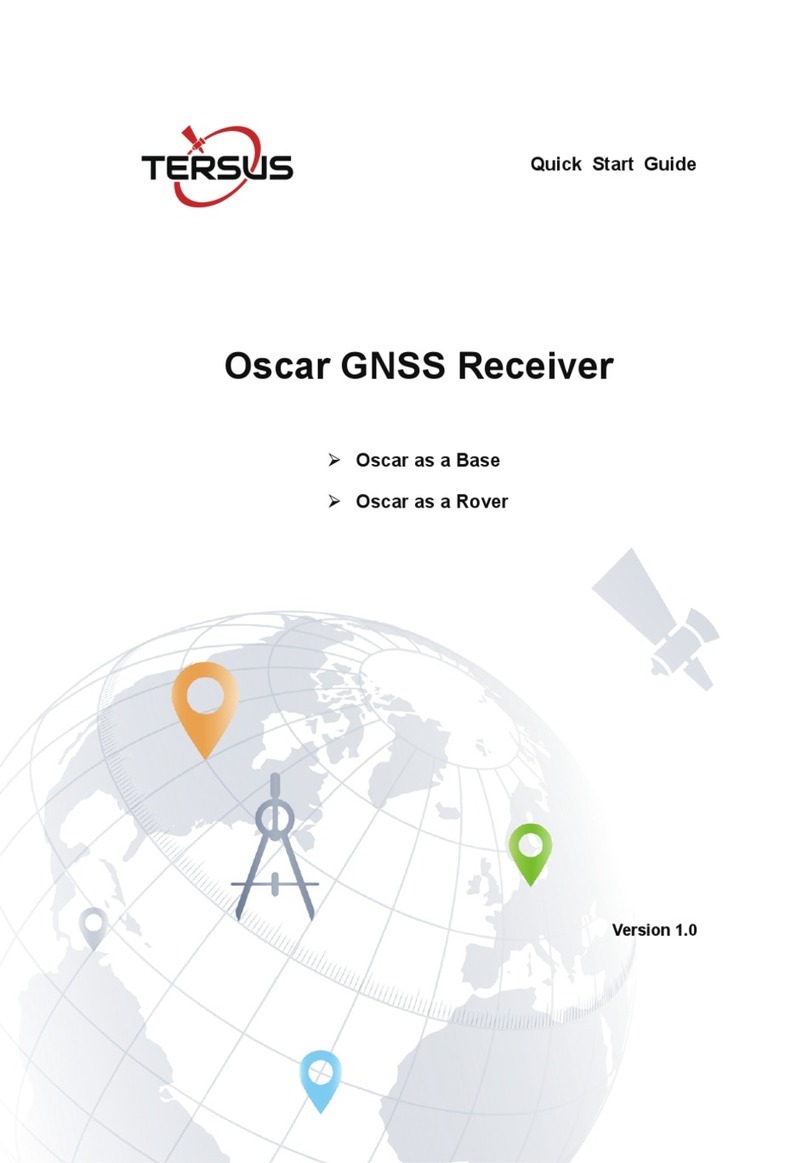
TERSUS
TERSUS Oscar User manual

TERSUS
TERSUS David User manual
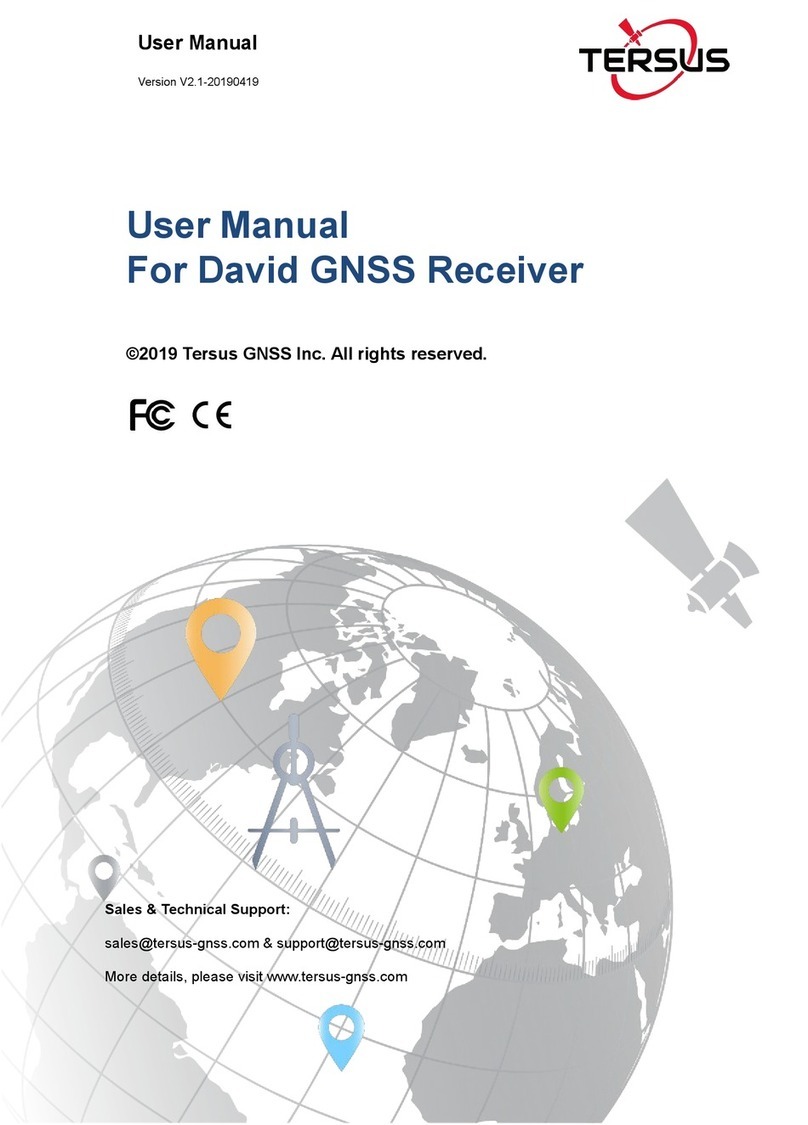
TERSUS
TERSUS David User manual
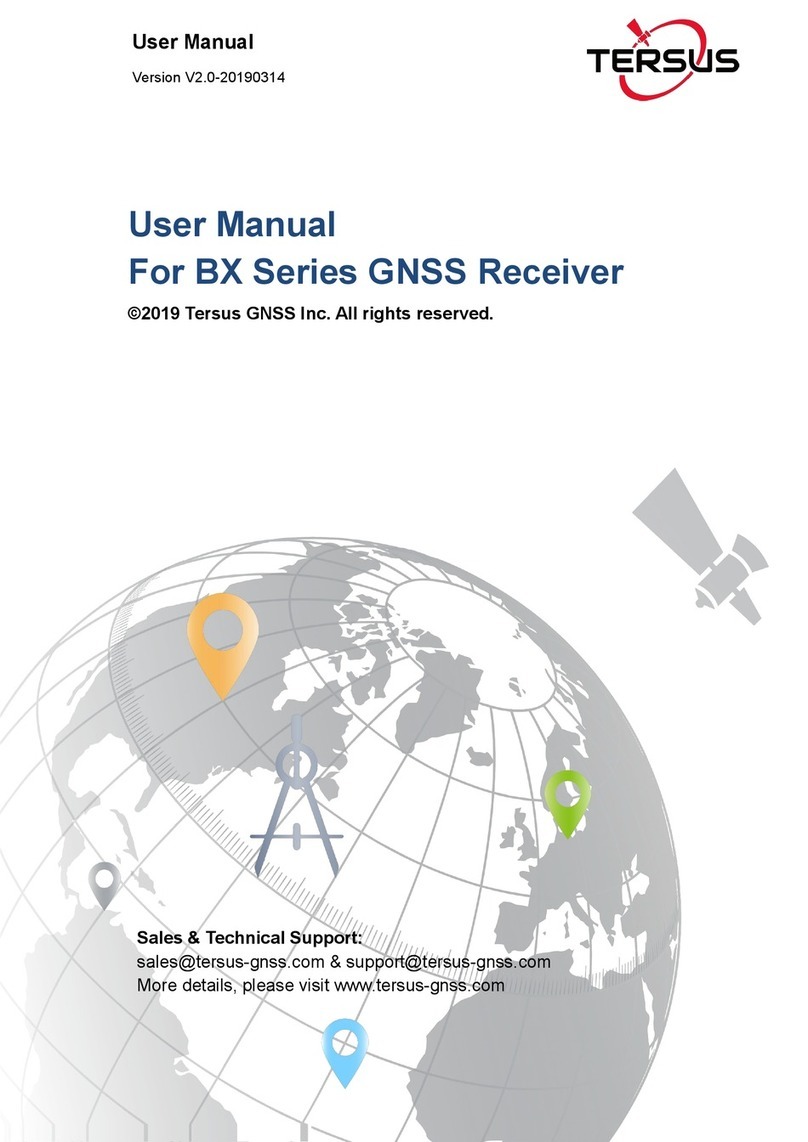
TERSUS
TERSUS BX306 User manual
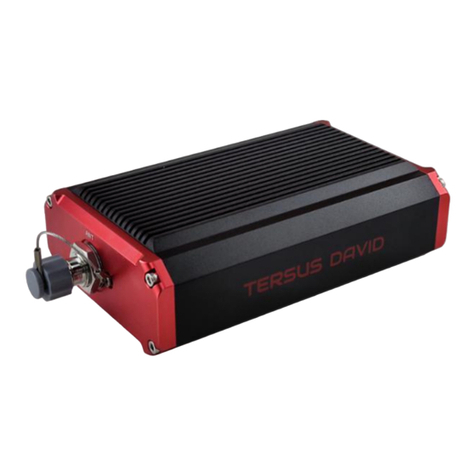
TERSUS
TERSUS David30 User manual
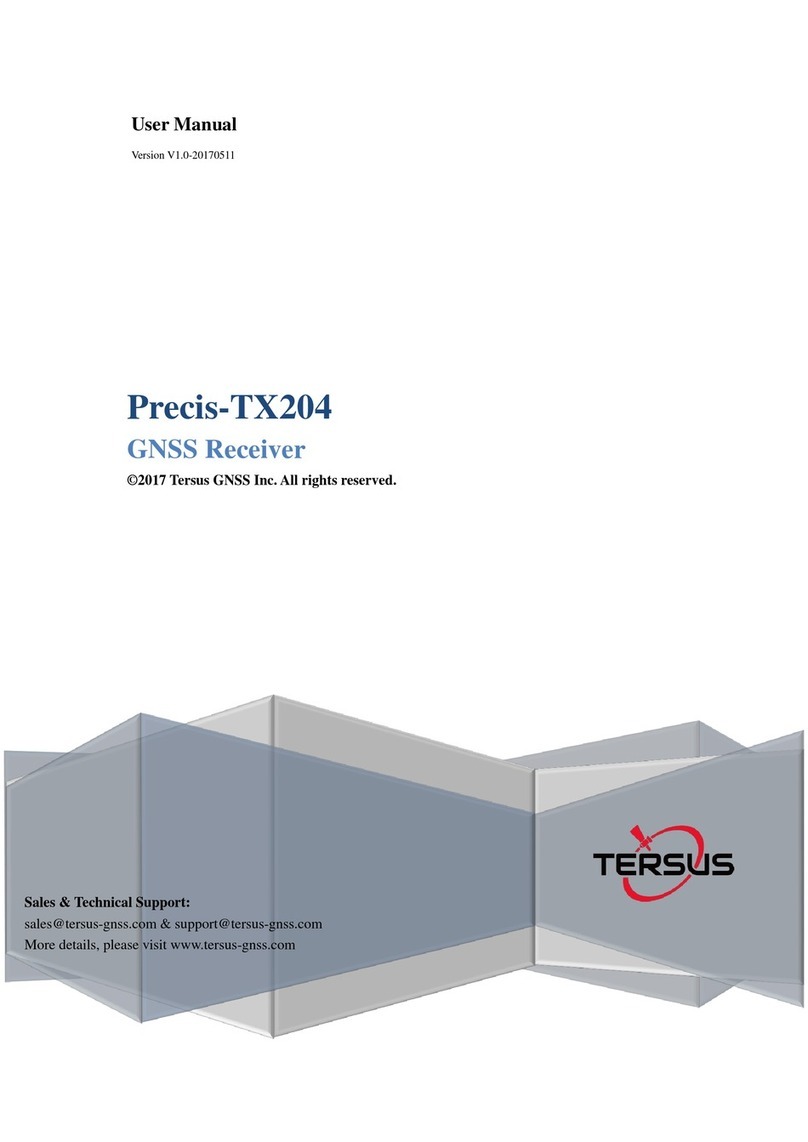
TERSUS
TERSUS PRECIS-TX204 User manual

TERSUS
TERSUS Oscar GNSS User manual
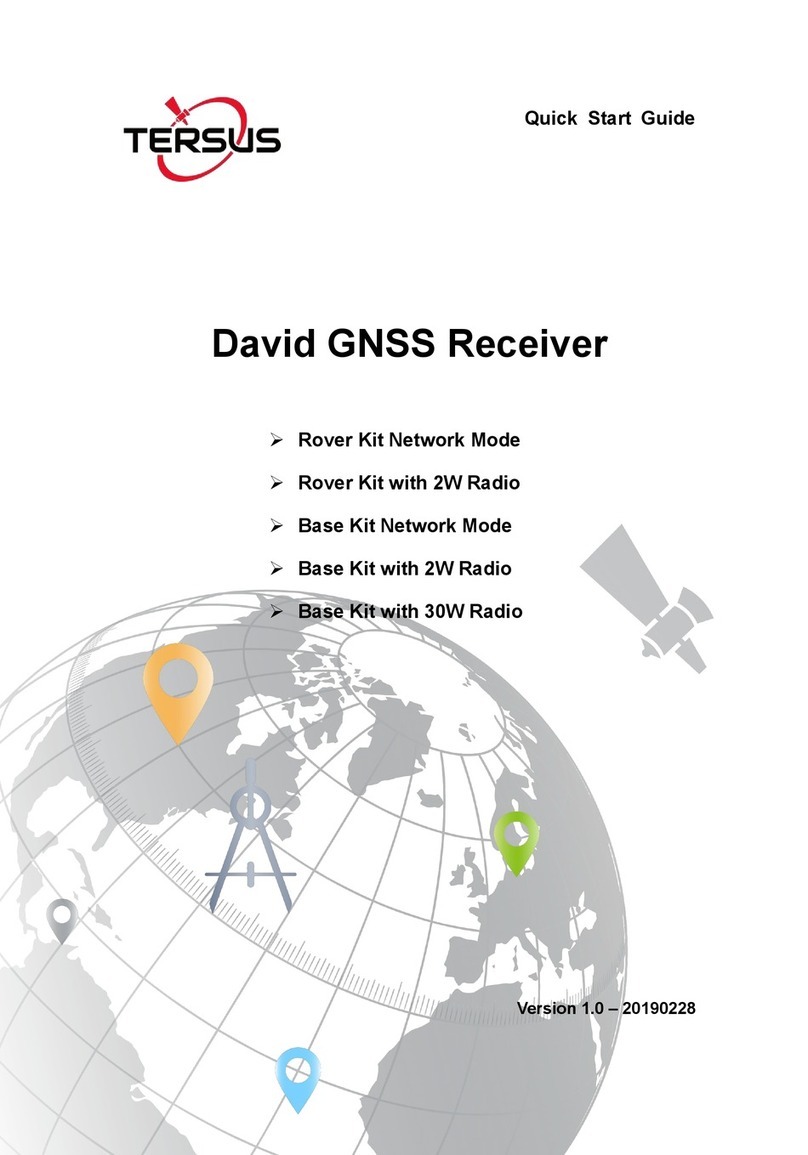
TERSUS
TERSUS David User manual
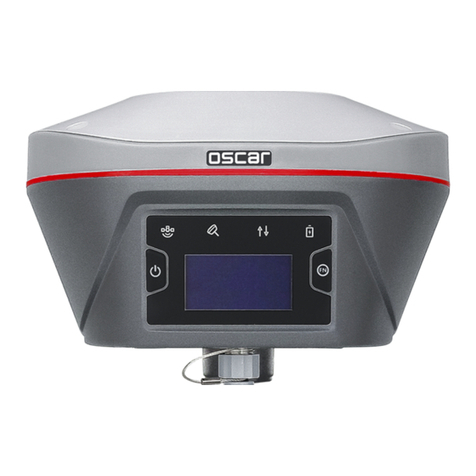
TERSUS
TERSUS Oscar Ultimate User manual

TERSUS
TERSUS David User manual
Popular Receiver manuals by other brands
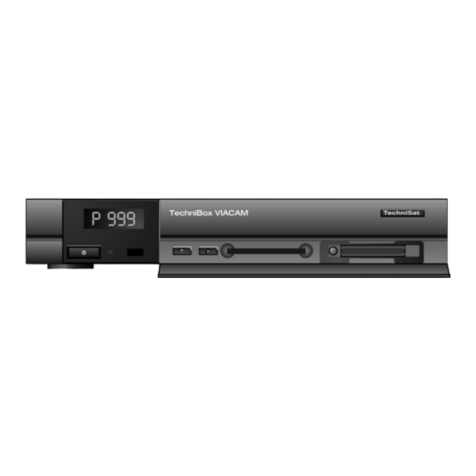
TechniSat
TechniSat VIACAM TechniBox VIACAM instruction manual
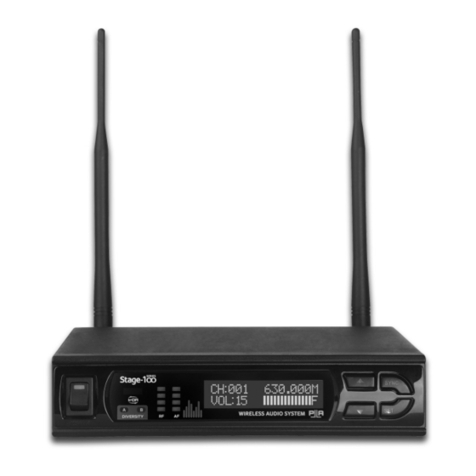
Parallel Audio
Parallel Audio Stage-100 Series Operation manual
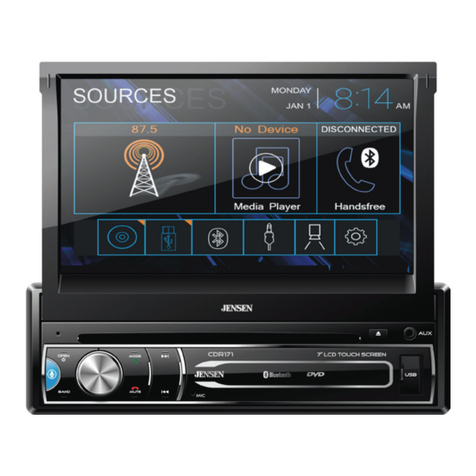
Jensen
Jensen CDR171 Installation & owner's manual
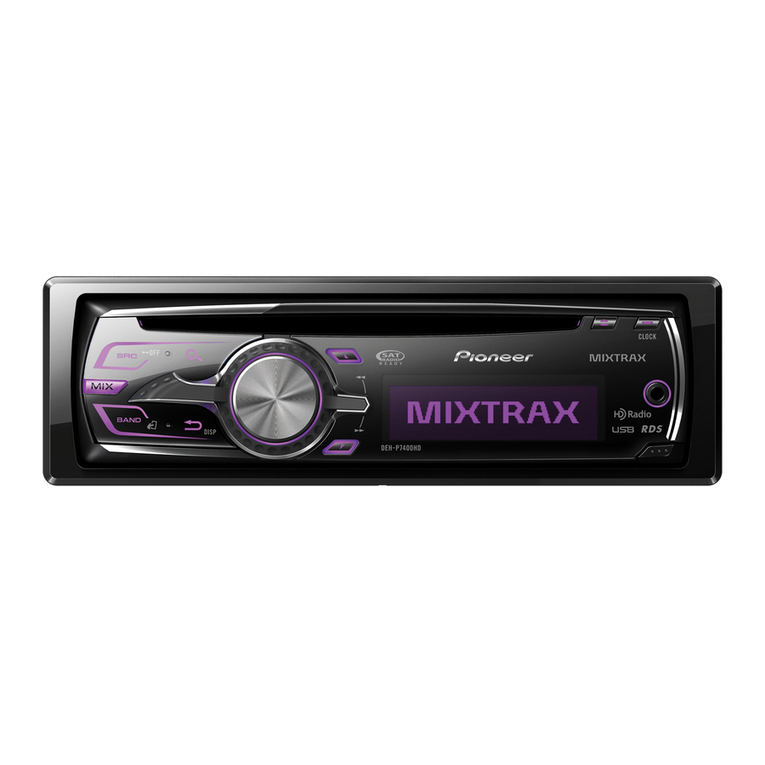
Pioneer
Pioneer DEH-P8400BH owner's manual
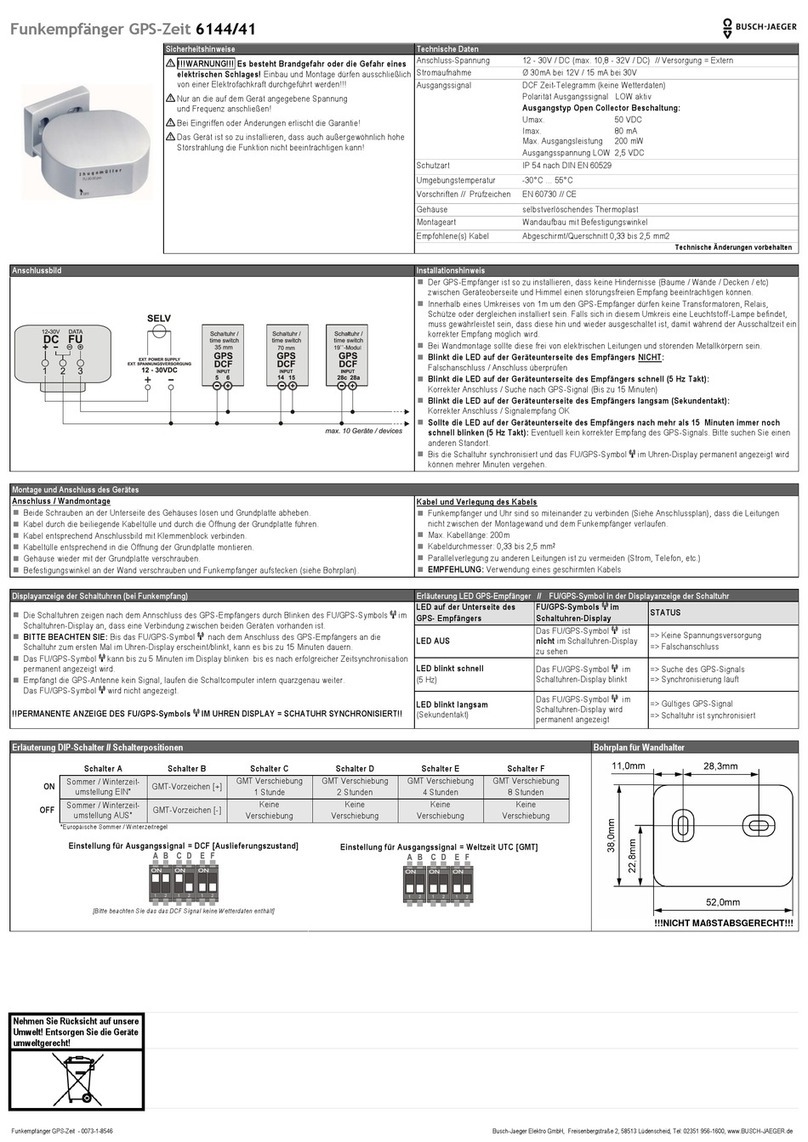
Busch-Jaeger
Busch-Jaeger 6144/41 quick start guide
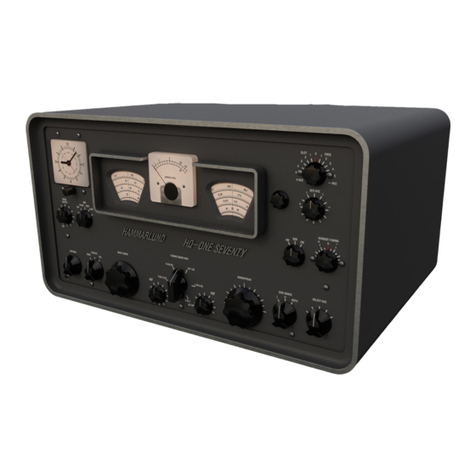
Hammarlund
Hammarlund HQ-170 Instruction and service information
